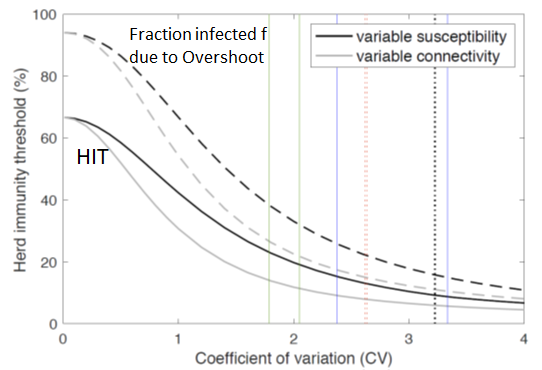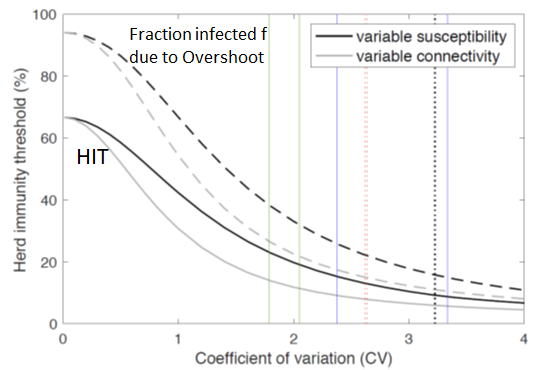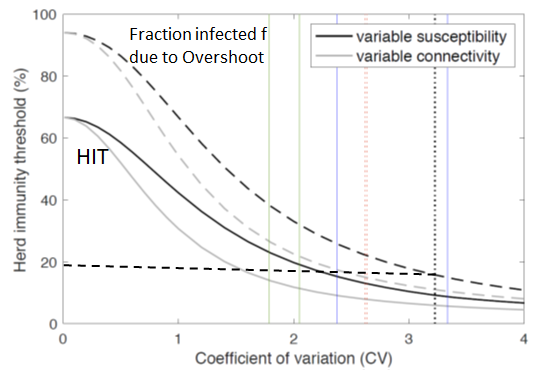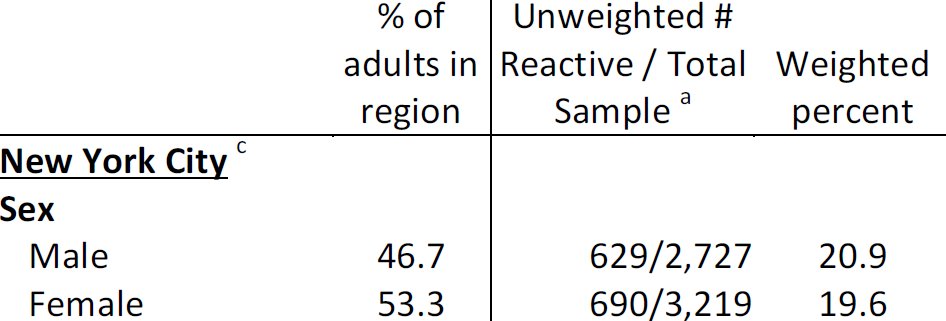What is #herdimmunity threshold for #COVID19?
A topic of much discussion due to large uncertainty & huge consequences for long term impact.
New paper illustrates 1 key aspect that can reduce it substantially (spoiler: we still don& #39;t know value). Thread.
https://science.sciencemag.org/content/sci/early/2020/06/22/science.abc6810.full.pdf">https://science.sciencemag.org/content/s...
A topic of much discussion due to large uncertainty & huge consequences for long term impact.
New paper illustrates 1 key aspect that can reduce it substantially (spoiler: we still don& #39;t know value). Thread.
https://science.sciencemag.org/content/sci/early/2020/06/22/science.abc6810.full.pdf">https://science.sciencemag.org/content/s...
Background: If we know reproductive number R0 for pathogen in population, herd immunity threshold (HIT) for WELL-MIXED HOMOGENOUS population is simply 1-1/R0.
(Note R0 varies w/ behavior, host traits, environment so differs over time&space).
(Note R0 varies w/ behavior, host traits, environment so differs over time&space).
In idealized population, early vaccination to HIT will prevent outbreak b/c Rt=R0*S/N so Rt<1. However, an epidemic will overshoot HIT & infect larger fraction f of pop where f=1-exp(-(f*R0)).
For R0=2.5 (reasonable for COVID19 in some pops), HIT=0.6, and f = 0.89.
For R0=2.5 (reasonable for COVID19 in some pops), HIT=0.6, and f = 0.89.
These simple calculations & flu data are what led @mlipsitch to make early widely cited rough back of the envelope calculations that 40-70% of pop would get infected without interventions. Most articles cited the 70%
*BUT* @mlipsitch knew that... https://www.cbsnews.com/news/coronavirus-infection-outbreak-worldwide-virus-expert-warning-today-2020-03-02/">https://www.cbsnews.com/news/coro...
*BUT* @mlipsitch knew that... https://www.cbsnews.com/news/coronavirus-infection-outbreak-worldwide-virus-expert-warning-today-2020-03-02/">https://www.cbsnews.com/news/coro...
Human populations are NOT WELL-MIXED & HOMOGENOUS, so calcs give likely upper bound.
Q: So what is herd immunity threshold (HIT) for real pops?
A: *Usually* lower & it depends on variation among individuals in 3 things: 1) contact rates; 2) susceptibility; 3) infectiousness.
Q: So what is herd immunity threshold (HIT) for real pops?
A: *Usually* lower & it depends on variation among individuals in 3 things: 1) contact rates; 2) susceptibility; 3) infectiousness.
1) If some individuals have few contacts then they are unlikely to be infected, lowering HIT. (note: variation in contacts can lead to faster early spread).
2) If some aren& #39;t susceptible to infection that reduces HIT.
3)If some people don& #39;t transmit that also reduces HIT.
2) If some aren& #39;t susceptible to infection that reduces HIT.
3)If some people don& #39;t transmit that also reduces HIT.
Positive correlations among these traits - if individuals w/ more contacts are more susceptible and infectious - can make for very rapid changes in dynamics. Sadly not much empirical data on these correlations & limited data on predictors of variation on susc. & infect.
However, see paper by @mgmgomes1 that is even better (b/c more general, better data) than Science paper cited above. Fig shows how variation susc, contacts affects HIT, f, for R0=3; so HIT=0.66, f = 0.94.
https://www.medrxiv.org/content/10.1101/2020.04.27.20081893v3">https://www.medrxiv.org/content/1...
https://www.medrxiv.org/content/10.1101/2020.04.27.20081893v3">https://www.medrxiv.org/content/1...
Science paper (link above) also shows how reasonable variation in contact rates among individuals reduces HIT. It considers differential mixing among age groups and hypothetical variation among individuals w/in each age group having more or fewer contacts.
The strange part is that it& #39;s not clear what source their age-mixing data comes from. The citation they give is NOT a published paper - it& #39;s a link to a page w/ Matlab files. It& #39;s weird because there are several age-mixing datasets out there. @sbfnk can probably provide best ones
The take home of the science paper is that pops partially structured by age (i.e. NOT well-mixed) and w/ arbitrary differential "activity" (contact rates) w/in ages can reduce HIT for R0=2.5 from 0.6 to 0.43.
The conclusion in the abstract is appropriately worded in making it clear that the paper is simply an illustration of a concept, not an actual estimate of the most likely value.
What I find puzzling is that this paper is in Science. It& #39;s a extremely simple modeling exercise, with arbitrarily chosen parameter values. It isn& #39;t as general as @mgmgomes1 paper cited above, and it& #39;s not clear it has any new empirical data. Many older papers say same thing.
@mgmgomes1 paper is much better in providing empirical estimates of heterogeneity & impacts on HIT, f based on data (colored lines in figure).
I& #39;d like to see uncertainty around those estimates of heterogeneity & some are very indirect estimates, but range of values is much better than arbitrarily chosen numbers and suggest heterogeneity is substantial. But ...
Serological data from NYC suggest that either heterogeneity estimate is too large or R0 is much larger, or lockdown did nothing to stop outbreak as seroprevalence is already at overhsoot epidemic size f (~20% - I added horiz dashed line).
https://www.sciencedirect.com/science/article/pii/S1047279720302015">https://www.sciencedirect.com/science/a...
https://www.sciencedirect.com/science/article/pii/S1047279720302015">https://www.sciencedirect.com/science/a...
Together papers suggest herd immunity thresh is <1-1/R0 and epidemic overshoot <f=1-exp(-(f*R0)), but by how much is still unknown. Ugh.
@mlipsitch smartly gave a wide range 40-70% (20-60% in later interviews) for fraction infected f w/out interventions. https://www.hsph.harvard.edu/news/features/coronavirus-covid-19-press-conference-with-marc-lipsitch-03-04-20/">https://www.hsph.harvard.edu/news/feat...
@mlipsitch smartly gave a wide range 40-70% (20-60% in later interviews) for fraction infected f w/out interventions. https://www.hsph.harvard.edu/news/features/coronavirus-covid-19-press-conference-with-marc-lipsitch-03-04-20/">https://www.hsph.harvard.edu/news/feat...
Unfortunately, uncertainties in variation in contact rates and susceptibility/infectiousness will prevent us from ever having precise value for HIT for 1 pop & it will vary among populations (as does R0). The take home message is want to get to HIT by vaccination NOT infection.

 Read on Twitter
Read on Twitter








